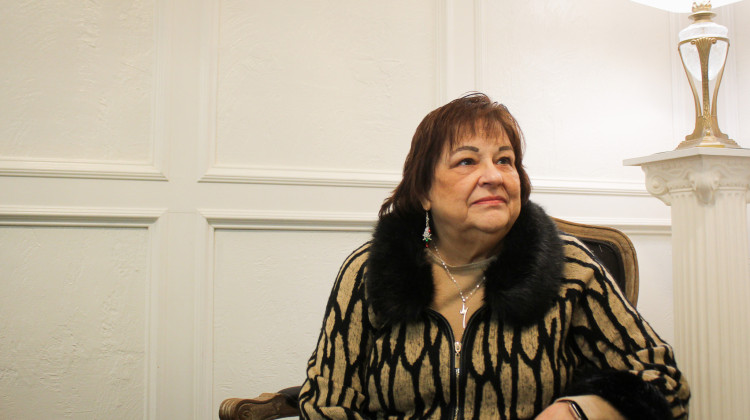
In the national spotlight as a performer with the Detroit Youth Choir, 17-year-old Symone has battled depression for years. She stands here with her mother, Que Jewelz, at their Highland Park home in Michigan.
(Erin Kirkland/Bridge Michigan)BY ROBIN ERB WITH BRIDGE MICHIGAN AND CARTER BARRETT WITH WFYI'S SIDE EFFECTS PUBLIC MEDIA
In most ways, Symone is like any other 17-year-old looking forward to her senior year in high school and what life may bring after — college and a career in music therapy or entertainment law, she hopes.
Her teenage years have included some notable highs. She shared the national spotlight as part of the Detroit Youth Choir, which was given a key to the city for “being the Heart, Soul and Spirit of Detroit.”
And yet, Symone said, she can suddenly feel despondent. It comes “randomly,” she said: “It’s like a mind battle.”
“I can have the best day ever, then suddenly I’m sad,” she said. “Like I want to be dead. I want to be dark. I can’t feel light, and I can’t feel happy.”
Which is why she offers this simple plea: “Don’t give up on people with mental health” issues.
In this series, Bridge Michigan and Side Effects Public Media have highlighted critical gaps in mental health resources for children and teens across the Midwest — that includes a shortage of psychiatrists, therapists and inpatient beds, and the warehousing of children in hospital emergency rooms as they wait for specialized treatment. It’s a system further strained by COVID-19.
Fortunately, nascent efforts are underway at the state and federal level to improve access to treatment. They range from placing more psychologists and social workers in schools, to encouraging more medical residents to pursue careers in child psychiatry, to deeper investment in public health, including funding for more psychiatric beds to help thousands of families with a child in despair.

Some say timing is right for an overhaul. Federal COVID stimulus funds can fuel the effort in ways not previously possible, including more money devoted to behavioral health as students across the country prepare a return to classrooms in the fall.
Here are seven ideas or legislative plans that may ease the burden and allow more young people like Symone to thrive:
More Psychiatrists, Sure. But How?
Pick just about any state and there are not enough psychiatrists who specialize in child or adolescent treatment, especially in rural areas.
The American Academy of Child & Adolescent Psychiatrists recommends 47 child psychiatrists for every 100,000 children. In Michigan, there are 11 per 100,000 children; in Indiana, it’s even worse at 6 per 100,000.
While the number of child psychiatrists has risen nationally in the past decade or so, there are still precious few and they tend to practice in more affluent, better educated and metropolitan areas. A 2019 study in the journal Pediatrics found that 70 percent of U.S. counties had no child psychiatrists. For example, Michigan’s rural Upper Peninsula, more than 300 miles long, has zero child psychiatrists.
Another impediment: Child psychiatrists tend to begin careers near the East- and West-Coast cities where they trained, said Dr. Sanya Virani, a trustee with the American Psychiatric Association.
So how might policymakers get more medical residents to choose this field? A greater focus on financial incentives such as student loan forgiveness or higher reimbursement rates might help, particularly if they are targeted to practicing in hard-to-reach regions.
Becoming a child psychiatrist typically requires five years of training beyond medical school. That means many newly-minted child psychiatrists enter the workforce with mountains of debt.
The Michigan State Loan Repayment Program offers up to $200,000 over eight years to medical professionals practicing in underserved areas. And this year, the program is prioritizing loan forgiveness for inpatient pediatric psychiatrists. MIDOCS, a collaboration among medical schools to boost training slots in Michigan, also offers loan forgiveness.
Of course, psychiatrists are only a single point on a larger spectrum of care. Loan forgiveness programs also are used to lure other critical staff, such as social workers or therapists who have racked up student debt.
More Inpatient Beds

As COVID-19 began to catch the world’s attention in December 2019, Beaumont Health broke ground on a $40 million, 100,000 square foot, 144-bed behavioral health hospital in Dearborn, near Detroit.
Officials say the facility, expected to open this year, will include 24 beds for children with depression, anxiety, schizophrenia, autism, anxiety, bipolar disorder, substance abuse orders or other mental health problems.
That will help ease a logjam of young people in emergency rooms awaiting beds, particularly in populous southeast Michigan. The hospital also will train psychiatrists — adding the first six psychiatry residents this year and ultimately training 24 at a time, though it’s unclear how many will specialize in children and adolescents.
“It's terrible to watch these kids in crisis. We just don't have enough resources right now for them,” said Dr. Whitney Minnock, medical director for the pediatric emergency room at Beaumont, Royal Oak.

Still, 24 beds is limited help.
Even if every one of Michigan’s 334 pediatric inpatient psychiatric beds were used — and they’re not, often because of lack of support staff — Michigan’s bed capacity still falls far short of what’s needed, experts said. The regions where beds are most scarce — such as northern lower Michigan and the Upper Peninsula — are five to 10 hours from the new Dearborn hospital.
Use One-Time Federal Stimulus Funds
Michigan Gov. Gretchen Whitmer and some lawmakers have proposed using Coronavirus State Fiscal Recovery Funds to boost behavioral health services in Michigan.
A House budget proposal passed in May would set aside $220 million for sweeping infrastructure improvements, including $100 million to expand long-term pediatric psychiatric inpatient services.
That would add as many as 120 inpatient beds for youth, said Laura Appel, vice president and chief innovation officer for the Michigan Health & Hospital Association, an industry group.
The MHA and Republican state Rep. Mary Whiteford, a registered nurse who has pushed for years for better mental health services in Michigan, helped drive the plan.
Another $85 million in the plan would build a new psychiatric center for children, replacing the aging Hawthorn Center, the state-operated inpatient facility in Northville, Michigan, for children and adolescents, Whiteford said.
The budget proposal also called for $15 million in renovations to hospital emergency rooms, which would, among other things, make them safer and more secure for suicidal patients as they await treatment.

So, for instance, ERs could be outfitted with rooms without door knobs or clothes hooks that patients in acute distress could use to hang or harm themselves.
Appel said people with mental illness also need an area set apart from the typical chaos of a busy ER, with soft or natural lighting to help calm agitated patients, similar to environmental features found in psychiatric facilities.
At Grand Rapids-based Pine Rest Christian Mental Health Services, the living and treatment areas have specialized furniture that is too heavy to throw. Staff consulted a botanist to ensure the indoor plants — designed to offer a soothing, outdoor feel to large spaces — are not toxic to a child who might try to eat them, a spokesman said.
The Michigan Legislature left for summer break recently without finishing the state budget. But lawmakers did finish work on a school spending bill, setting aside $240 million to place more psychologists, school social workers, school counselors and nurses in schools.
These positions are “essential” and schools are “uniquely suited to assist youth with mental health concerns,” noted the nonpartisan Citizens Research Council of Michigan, a public affairs research group. The CRC released its own findings this week on child mental health care services, noting the lack of school staff available to assist students in crisis. Other researchers have expanded that idea to include integrating behavioral health into primary-care pediatric settings as well.
In May, the federal Substance Abuse and Mental Health Services Administration announced $3 billion in American Rescue Plan funding to support mental health and substance use grant programs across the U.S. That included nearly $42 million of new funding for community mental health centers in Michigan and more than $25 million in Indiana.
That followed $2.5 billion in SAMHSA payouts to states in March.
Intervene Early
Mental-health advocates say it’s critical to intervene early with those most in need.
Boosting school- and home-based programs helps identify and treat mental illness sooner, before a young patient falls into crisis, Dr. Michelle Morgan, a retired psychiatrist in the U.P., recently told residents at a community meeting in Eagle River.

Early action also helps law enforcement, especially in rural areas that operate with just a handful of officers each day.
Sheriff Joe Brogan of Baraga County in the U.P. told residents at the same meeting that when officers respond to a person in mental distress other emergencies get missed. “We don’t have anybody answering calls for service,” he said.
Michigan is one of several states working to provide police with training to better identify mental illness in people they encounter and get them into treatment centers for evaluation and help rather than sending them to jail.
Indiana has turned to a program called “high-fidelity wraparound” as a way to address complex behavioral issues in young people so they don’t get to the point of needing inpatient care.
Under the wraparound model, a case manager is assigned to coordinate a child’s care, which might involve therapists or other medical professionals as well as social workers, teachers and parents. Indiana’s Medicaid program offers this service to qualified families.
Wraparound services are useful when traditional methods of supporting a child’s mental health needs are unsuccessful. The goal is to de-escalate a problem before it reaches crisis stage, said Ebony Reynolds, clinical officer of Detroit Wayne Integrated Mental Health, which manages providers for families in Wayne County.
Families “deserve a system that's responsive to their needs, rather than just getting thrown whatever it is this system has to offer,” said Kimberly Estep of the National Wraparound Implementation Center.
Another key to early intervention is round-the-clock access to mental-health support, said Whiteford, the state representative. She sponsored legislation that led to a 24-hour Michigan Crisis and Access Line that opened in April in Oakland County and the Upper Peninsula.
The crisis line, which also takes calls from those who who dial the National Suicide Prevention Lifeline, will be accessible across the state by fall 2022.
“It folds all these hotlines into a one-stop shop for anybody who needs help — from a police officer to a nurse in an emergency room to a mom worried about her child,” Whiteford said.
The line will also have access to Michigan’s Inpatient Psychiatric Bed Registry, allowing callers — from ER staff to parents — to learn sooner if there is an available psychiatric bed or service in their area.
U.S. Senators Debbie Stabenow, a Michigan Democrat, and Roy Blunt, a Missouri Republican, helped lead an effort this spring to earmark $489 million in federal funds to expand Certified Community Behavioral Health Centers, part of a federal network that can immediately screen people in crisis, regardless of their ability to pay, and get them help. Of the amount, nearly $20 million is headed for Michigan to support efforts at five Detroit centers.
Early Intervention Part Two: School Screenings
In 2018, the Lansing-based advocacy nonprofit Disability Rights Michigan filed a class-action suit, K.B. versus Lyon, accusing the state of Michigan of “staggering failures to provide needed mental health services to thousands of children and their families.”
Kyle Williams, director of legal advocacy for the advocacy group, said one crucial step in addressing systemic failures is a universal screening tool that would identify children in need, trigger a full assessment and connect them to services before they spiral into crisis. It could be used by school counselors for a child acting out in class or staff at a juvenile justice facility after a child has been picked up by police, he said.

A child in crisis “doesn’t have the time to wait three years for an intensive service array,” Williams said.
“If you don’t pair home- and community-based services (with inpatient care), you’re looking at a cycle in which kids end up in an ER bed, return to the community, and keep destabilizing, then return to the ER again,” Williams said.
Details are still being hammered out in a settlement agreement in the lawsuit after several extensions — the latest extension is to Sept. 1.
Ease Bureaucracy
Parents have enough worry when a child is in crisis. But many are forced to change jobs or quit to become full-time advocates for their children as they work through layers of bureaucracy, said Jane Shank, executive director of the Lansing-based Association for Children’s Mental Health.
“Parents get beaten down a little,” she said.

As it stands now, Medicaid funds flow through Michigan’s mental health managed care system which is made up of 10 Prepaid Inpatient Health Plans, or PIHPs, throughout the state.
They pay for treatment and services at local Community Mental Health Agencies, which in turn, may contract with other providers. With each layer, accountability disappears, according to critics.
Rep. Whiteford said she would replace the state’s 10 managed care organizations with a single oversight body — moving the state closer to a fee-for-service health system and making the state accountable rather than diffusing accountability through layers of managed care bureaucracy.
It also would lead to “ significant reduction in administrative costs,” according to the nonpartisan Michigan House Fiscal Agency. Michigan Senate Majority Leader Mike Shirkey, whose overhaul plan includes privatizing much of mental health care, also wants to downsize or eliminate the PIHP managed care system.
Critics argue, however, that such plans replace one layer of a bureaucracy with another and that projected cost savings are exaggerated.
“It’s a different terrain across the state — the availability of services, the availability of staff,” said Kevin Fischer, of the Michigan chapter of the National Alliance on Mental Illness.
He said the Whiteford and Shirkey plans include good ideas, but he worries about moving to a single managed care system or oversight agency.
Locally run managed care matches local needs to the best local resources, he said, saving money and providing better care.
“The people in Houghton or Marquette (in the Upper Peninsula) know what they need better than the people in Detroit do,” he said.

More Telemedicine To Reach Distant Children
The field of telemedicine dramatically expanded during the pandemic, in part due to relaxation of regulations by the federal government and private insurers amid COVID.
A Centers for Disease Control and Prevention study noted a 154 percent increase in telemedicine usage in March 2020, as the pandemic first hit, compared to the previous year. Telemedicine can be useful for people without reliable transportation or from rural areas without a nearby provider. It can also help parents avoid taking time from work to transport children to therapist appointments.
With so many regions in Michigan and Indiana lacking in mental health providers, strengthening telehealth can help improve access to care.
But barriers remain. Indiana-based research shows Black and rural populations are less likely to have reliable internet or a home computer. And despite a year of remote learning, children may have more trouble engaging with mental health professionals on the computer.
It remains unclear if private insurers will continue to pay for telehealth visits once the pandemic fades. Policies can differ by insurer, state or particular plan. Many states, including Michigan, have enacted parity laws that require insurers to equitably cover in-person and telemedicine visits.
This story is the third part of a three-day series produced by Bridge Michigan and WFYI's Side Effects Public Media in collaboration with the Institute for Nonprofit News. The project was made possible by a grant from the Robert Wood Johnson Foundation with additional support from INN's Amplify News Project and the Solutions Journalism Network.
To read all the stories included in the project, click here.
 DONATE
DONATE







 View More Articles
View More Articles



 Support WFYI. We can't do it without you.
Support WFYI. We can't do it without you.